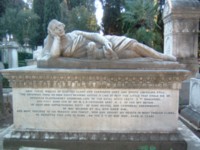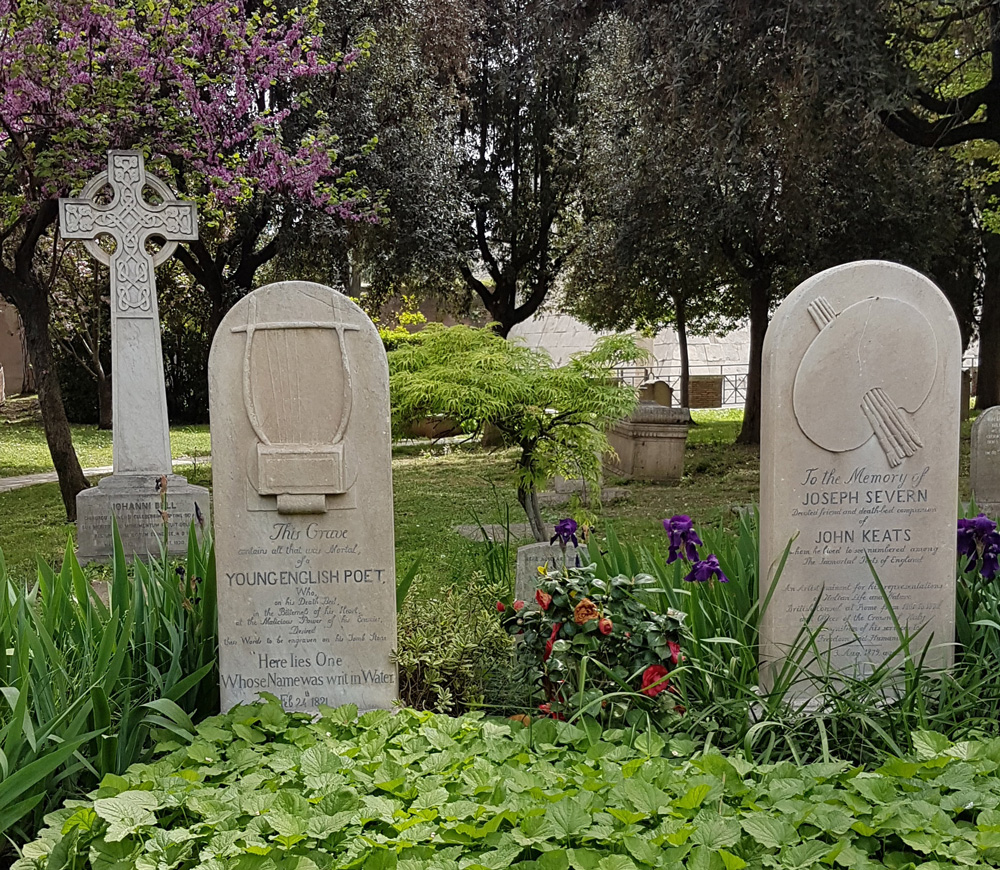Surely one of the finest places in the world to be buried, Rome’s Protestant Cemetery is a peaceful oasis of green next door to the Pyramid of Caius Cestius. More properly known as the Cimitero Acattolico, or non-Catholic cemetery, this lovely spot houses the graves of Keats and Shelley.
Note: although entrance to the Protestant Cemetery is free, consider making a donation towards the graveyard’s upkeep in the box provided.
Keats (1795-1821) lies in a quiet corner in the oldest part of the Cemetery, his simple tombstone graced by a sad and bitter epitaph:
This Grave contains all that was Mortal of a YOUNG ENGLISH POET, Who on his Death Bed, in the Bitterness of his Heart at the Malicious Power of his Enemies, Desired these Words to be engraven on his Tomb Stone. Here lies One Whose Name was writ in Water. Feb 24th 1821.
Next to Keats’s tomb is that of the artist Joseph Severn (1793-1879). Severn was a close friend of Keats, and was with him in Rome when the poet died. He was responsible for the design of his friend’s grave. Later in life Severn held the post of British Consul in Rome.
Percy Bysshe Shelley (1792-1822) spent the last few years of his life travelling around Italy with his wife, the author Mary Shelley. On the 8th July 1822, while living at Lerici (near La Spezia), Shelley drowned in a sailing accident. After his cremation on the beach, Shelley’s ashes were brought to Rome for burial. The Shelleys’ son is also buried in the Cemetery, which Shelley had described as a spot so beautiful ‘it might make one in love with death, to be buried in so sweet a place’.
Cats stroll in the shade of cypresses, where gravestones remember, among hundreds of others, Shelley’s friend Trelawney, Goethe’s son Julius, R.M. Ballantyne and Italian Communist Antonio Gramsci.
A charming and romantic spot, the cemetery is far removed from the chaos and noise of Rome. A wander around the graves is a moving experience, and offers a fascinating insight into ‘expat’ life and death in the city over the past two centuries.

The Protestant Cemetery is located next to the Pyramid of Caius Cestius, by Piramide metro station. The entrance is on Via Caio Cestio; ring a bell at the gates to gain admittance. The Cemetery is open on a daily basis, from 9-4.30 or 9-2 on Sundays and public holidays. Don’t despair if you miss the opening times. A helpful window in the wall, close to the corner with Via Marmorata, gives you a perfect view of Keats’s grave. The British Military Cemetery is close by.
Combine the Protestant Cemetery with:
- Via Appia Antica (Appian Way) – Bus number 118 from outside Piramide metro station.
- Circo Massimo and the Aventine Hill – The Pyramid and Cemetery are located over the Aventine from the Circo Massimo.
- Tram number 3 runs from Trastevere to Porta San Paolo / Piramide, and on to the Circo Massimo, the Colosseum and San Giovanni.
- Express bus number 30 connects Piramide with the Centro Storico.
- The metro from Piramide runs to Termini (via the Colosseum) in one direction, and towards EUR in the other.
- Trains from the station go to Ostia Lido, stopping at Ostia Antica.
Useful external links
